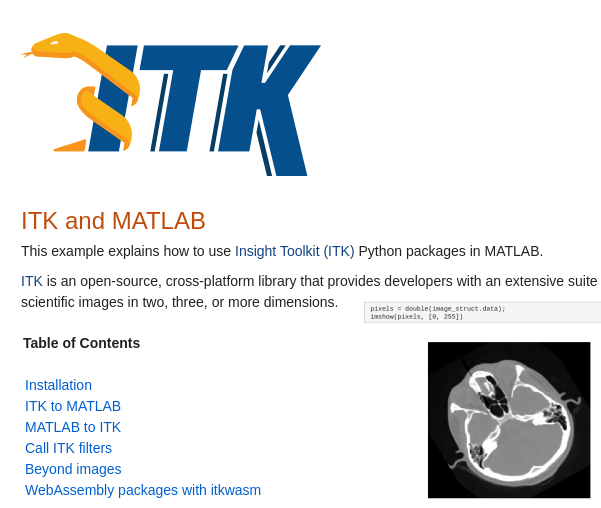Meet the Team
Brad Moore, Ph.D.
Staff R&D Engineer
Kitware North Carolina
Carrboro, NC
Ph.D. in Computational Biology and Bioinformatics
Duke University
M.S. in Computer Science
The Ohio State University
B.S. in Computer Science
The Ohio State University
Brad Moore, Ph.D. is a staff R&D engineer on Kitware’s Medical Computing Team located in Carrboro, North Carolina. He is currently involved in proposals that include point-of-care ultrasound and AI. His projects also involve genomics, bioinformatics, and image analysis.
Brad currently leads the Traumatic Brain Injury project funded by the MTEC Consortium and the U.S. Government. This project uses deep learning and image analysis to automatically measure the optic nerve sheath diameter from ultrasound video acquired by novice operators (e.g. medics and first responders) using point-of-care ultrasound devices.
In addition to his technical work, Brad also mentors Kitware’s Open Source Software Technology Program (OSTP) participants. He also participated in the Education Working Group “State of AI in Ultrasound Imaging” during the Annual Integrative Ultrasound Meeting (AIUM) 2021.
Prior to joining Kitware, Brad was the senior director of facilities and technologies at Galloway Ridge in Pittsboro, North Carolina. He was the head of security, housekeeping, facilities, and IT departments and led operation strategy and large capital projects for the large senior living community. He worked to enrich the lives of the seniors and helped them maintain their independence through technology, which included digital visitor sign-in, virtual reality (VR), and free resident IT support.
Brad was also a research assistant and a research software engineer at Duke University. As a research assistant, he designed and conducted population sequencing experiments. He also developed a novel Illumina unique molecular identifier (UMI) and an open source ImageJ application for measuring worm size in microscopy images. As a research software engineer, Brad worked on robotic control of a motorized microscope stage and the segmentation and analysis of fluorescent microscopy gene reporter experiments in Arabidopsis Thaliana.
Brad received his Ph.D. in computational biology and bioinformatics from Duke University in 2017. He received both his master’s and bachelor’s degrees in computer science from The Ohio State University in 2005 and 2004, respectively.
Awards
MTEC 2021 Prototype of the Year Award, 2021
Best Demonstration Runner Up, “Automatic Optic Nerve Sheath Measurement in Point-of-Care Ultrasound”, MICCAI ASMUS, 2021
Invited Talks & Media
Invited talk, “Automatic Optic Nerve Sheath Measurement in Point-of-Care Ultrasound,” IEEE AI4US Workshop, 2021
Publications
- R. Yu, D. Du, R. LaLonde, D. Davila, C. Funk, A. Hoogs, and B. Clipp, "Cascade Transformers for End-to-End Person Search," in Proceedings of the IEEE/CVF Conference on Computer Vision and Pattern Recognition, 2022. [URL]
- B. Moore, S. Montgomery, M. Niethammer, H. Greer, and S. Aylward, "Automatic Optic Nerve Sheath Measurement in Point-of-Care Ultrasound," in Medical Ultrasound, and Preterm, Perinatal and Paediatric Image Analysis. Springer International Publishing, 2020, pp. 23-32. [URL]
- A. Webster, A. Hung, B. Moore, R. Guzman, J. Jordan, R. Kaplan, J. Hibshman, R. Tanny, D. Cook, E. Andersen, and L. Baugh, "Population Selection and Sequencing of Caenorhabditis elegans Wild Isolates Identifies a Region on Chromosome III Affecting Starvation Resistance," G3: Genes|Genomes|Genetics, vol. 9, no. 10, pp. 3477-3488, Oct. 2019. [URL]
- B. Moore, "Population Sequencing for Studying Natural and Artifcial Variation in C. elegans," Duke University, 2017.
- J. Hibshman, A. Doan, B. Moore, R. Kaplan, A. Hung, A. Webster, D. Bhatt, R. Chitrakar, M. Hirschey, and L. Baugh, "daf-16/FoxO promotes gluconeogenesis and trehalose synthesis during starvation to support survival," eLife Sciences Publications Limited, vol. 6, pp. e30057, 2017.
- R. Kaplan, Y. Chen, B. Moore, J. Jordan, C. Maxwell, A. Schindler, and L. Baugh, "dbl-1/TGF-β and daf-12/NHR Signaling Mediate Cell-Nonautonomous Effects of daf-16/FOXO on Starvation-Induced Developmental Arrest," PLOS Genetics, vol. 11, no. 12, pp. e1005731, Dec. 2015. [URL]
- B. Moore, J. Jordan, and L. Baugh, "WormSizer: High-throughput Analysis of Nematode Size and Shape," PLoS ONE, vol. 8, no. 2, pp. e57142, Feb. 2013. [URL]
- C. Topp, A. Iyer-Pascuzzi, J. Anderson, C. Lee, P. Zurek, O. Symonova, Y. Zheng, A. Bucksch, Y. Mileyko, T. Galkovskyi, B. Moore, J. Harer, H. Edelsbrunner, T. Mitchell-Olds, J. Weitz, and P. Benfey, "3D phenotyping and quantitative trait locus mapping identify core regions of the rice genome controlling root architecture," Proceedings of the National Academy of Sciences, vol. 110, no. 18, pp. E1695-E1704, Apr. 2013. [URL]
- W. Busch, B. Moore, B. Martsberger, D. Mace, R. Twigg, J. Jung, I. Pruteanu-Malinici, S. Kennedy, G. Fricke, R. Clark, U. Ohler, and P. Benfey, "A microfluidic device and computational platform for high-throughput live imaging of gene expression," Nature Methods, vol. 9, no. 11, pp. 1101-1106, Nov. 2012. [URL]
- B. Moore and P. Sivilotti, "Plausible Clocks with Bounded Inaccuracy," in Distributed Computing. Springer Berlin Heidelberg, 2005, pp. 214-228. [URL]

